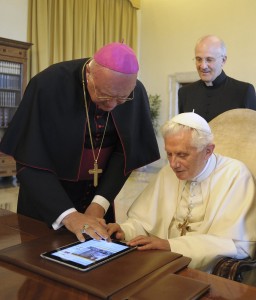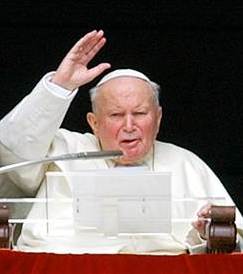For many people, “Vatican” and “technology” don’t go together. The Catholic Church is often accused of being behind the times with new media, whether it’s the Vatican’s outdated website or its relative absence in the world of social networking.
However, the Pontifical Council for Social Communications is aiming to change all of that. Over the past few years, the Vatican dicastery has sponsored many innovative projects including:
- Last May’s Vatican Blogger Meeting in Rome which gathered Church leaders and bloggers from around the world
- The elegant News.va site, which features social media integration
- The @Pope2YouVatican Twitter account with special tweets during #lent
- The recent purchase of a new “.catholic” top-level domain
Archbishop Claudio Celli is President of the Pontifical Council for Social Communications, and is the man behind many of these projects. I had the great pleasure of meeting him at the recent Catholic Media Conference and a couple things struck me immediately.
First, he’s surprisingly funny. Archbishop Celli looks very stoic and solemn in most photographs. But in person, he’s a big jokester.

Before I gave my talk on the “7 Deadly Sins of New Media“, the Archbishop announced to everyone that he would be available for absolution afterward for anyone who needed it. He had people in stitches throughout the day with his witty one-liners and wisecracks.
A second striking trait is his deep reflectivity. Archbishop Celli is a contemplative intellectual in the mold of Pope Benedict XVI, and like the pontiff is particularly discerning when it comes to technology. If I had to guess, Archbishop Celli played a significant role in crafting several of Pope Benedict’s recent World Communication Day messages, which deal with themes like “Silence and the Word” and “Truth, Proclamation and Authenticity of Life in the Digital Age.”
When you listen to the Archbishop speak on technology, you feel like you’re sitting at the feet of a modern Gandalf. With careful words and pregnant pauses, he speaks like a wise sage, as someone who has pondered social communications from many angles–philosophically, socially, and religiously. All he needs is a pipe and some smoke rings.
The Archbishop graciously sat down with me at the Conference to discuss several things including the role of silence in communication, the Vatican’s new media work, and a special eBook project in the pipelines for the Year of Faith. Watch or read below!
(We filmed the interview with an iPad in a crowded hallway, so there is some background noise. If you miss any of the Archbishops’s insights, you’ll find the full transcript below.)
Video
Topics Discussed:
0:34 – How is the Internet changing our view of the Church?
3:12 – The importance of silence in communication
5:29 – Rediscovering the Internet’s “human aspect”
6:59 – The Internet as a parable for the Communion of Saints
7:56 – The Vatican’s special projects for the Year of Faith
9:49 – Year of Faith eBook
11:49 – Archbishop Celli on the Digital Church Conference
Transcript
BRANDON: I’m here with Archbishop Claudio Celli, who is the President of the Pontifical Council for Social Communications over in the Vatican. He joined us today during our Digital Church Conference talks, and it’s been a joy to have him. He’s one of the funniest men around and he’s cracking jokes left and right. But today I wanted to ask him a couple questions about what’s going on in the Vatican, specifically in regards to new media.
First, we had a great conversation earlier today about the philosophy behind new media, and the way that it’s changing people’s understanding of the Church. You had some great insights about how the Internet mimics the invisible communion of saints. Can you talk about that a little bit more?
ARCHBISHOP CELLI: It’s like a parable. We can take what we are on the Internet, and as you know people are very fond of being connected. Connection today is very important for our life. It means that if you are connected, you are in touch with, and your capacity of knowledge—your capacity of relationship—[is] increased, just because you are connected.
In a certain sense, you are overcoming your solitude. It is funny: this is the problem of today. We have many facilities for being in communication with other people, and we suffer so deeply from solitude. We are touching one of the delicate aspects of communication today because in its content, communication is expressing the relationship between a man and another man, between a person and other persons.
But today on many occasions, the new technologies are giving us the capacity to get in touch with, but afterwards it depends on my heart, or my mind, to create a real communication with others. It’s not automatic. It means that new technologies are giving me an opportunity, but it depends on me what content I’m giving to such an opportunity. This is why we must enrich our dialogue.
Here again we are discovering the importance of silence. Because I need to give relevance to give depth to the words I am saying. Otherwise I can just pronounce sounds, but I don’t realize a deep communication with other people. I think this is one of the big challenges for us, the Church—how we help people rediscover the real meaning of communication. It’s a heart-to-heart dialogue.
 And we need to rediscover the importance of silence, because to have a real communication you need a moment of silence to understand, to perceive what the other person is eager to tell you—wants to tell you.
And we need to rediscover the importance of silence, because to have a real communication you need a moment of silence to understand, to perceive what the other person is eager to tell you—wants to tell you.
You can perceive it immediately when you have two persons in love. They don’t need to talk too much. They just walk hand-in-hand because there is a deeper communication. Now, also in our daily life, if we are in search for truth, we need to give relevance and to perceive what I can have in my silence, the acceptance of the other; I’m making space in my heart for the other. And also, I am understanding his words. I’m giving relevance to the words that I’m saying to him or her.
Today, in the field of the new technologies, again and again we’re discovering the value of the human aspect. Because otherwise we have empty words, empty communication. But certainly, the new technologies are giving me an opportunity to be in a relationship with others, to be connected with others.
You were talking about that this afternoon. What happens in the Church? In Christ, we belong to one another. We are forming one Body in Christ. We are not only connected but we are in communion. Connection is one thing; communion is a deeper feeling, and this deeper feeling is to be in Jesus Christ. In Him, and with Him, in His Spirit we are forming one Body—the mystical Body of Christ.
But certainly our people, especially our young generations, they understand much better today the meaning of communion because they know what it is to be in connection with.
So this Internet, I could say, is like a symbol, like a parable. Probably today, Jesus would use such a parable to [show how] to be connected in the social network. But he is offering us something more, and more important. Again, we are not only connected in a social network, but in Him we are united, we are belonging to one another.
This is really something great, all the marvelous things Jesus did for us. In such a connection, such a communion, we are receiving new life and this is great.
BRANDON: Now you talked about reclaiming the human aspect of new media, and the Pontifical Council is doing just that. You guys have a really special project coming up for the Year of Faith. Can you talk a little bit about what you’re planning?
ARCHBISHOP CELLI: Yes, we are planning to, first of all, increase among the Church the meaning of communication. You know, sometimes we are too intellectual, connecting communication mainly to words. But, for example, I can communicate to you my friendship with a smile. I can communicate my friendship with my eyes. I can touch you. And all of this is communication.
 If you remember, to me it was very significant, the last appearance of John Paul II at the window. He was not able to say one word, but with his face, with his eyes, was expressive, was communicating to the world what was in his heart. No words, but a deep, a real deep communication.
If you remember, to me it was very significant, the last appearance of John Paul II at the window. He was not able to say one word, but with his face, with his eyes, was expressive, was communicating to the world what was in his heart. No words, but a deep, a real deep communication.
So I think for us, one of the tasks of our Council is to really help the Church rediscover the real meaning of communications.
Second, one of the projects—the next project for the Year of Faith—will be an eBook where we will have many chapters. We’re requesting the collaboration of the local churches to increase the pages of every chapter of this book. At the end of the Year of Faith, we will have a book with the participation of many local churches sharing their experiences from the Year of Faith.
Consider, for example, a song. Why don’t you make a contest among the young generations in the States? Who is going to create the best song? Because also, this is communication. Sometime I joke saying that one good song is more reflective than 1,000 of my homilies because young generations communicate with music, with songs.
So for example, this is a challenge for you: why don’t you ask the many, many young people in the States to participate in a song contest for the Year of Faith, where the young generations can express their suffering, their happiness, their joy, their struggle to living free through Jesus? This will be great. This can be a page in our eBook.
BRANDON: Again, thanks for joining us, and before we finish, you sat in for some of our Conference—the Digital Church Conference that we’re sharing around the country—can you give one sentence on why you think this Conference is a good thing?
ARCHBISHOP CELLI: Because it’s helping us to understand that certainly we communicate with Jesus through our testimony. We are called to be witnesses. But we have to be witnesses also in the digital culture, in the digital world. Your Conference, with the three of you, is helpful to rediscover such an important place, such an important space where we can express and announce Jesus. So good luck and God bless you for everything you’re doing!
If you liked this discussion, you can find several more on my Interviews page. Be sure you don’t miss future interviews by subscribing to the blog via feed reader or email.
What is the role of ‘silence’ in communication?
(Image Credit: Salt & Light TV, Today’s Catholic News, MSNBC, Kentucky.com)

